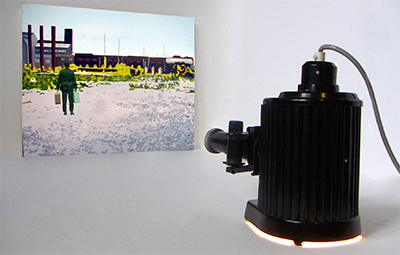Installation view
( Please scroll down for article in German )
Walkout Installation, 2003
Video projection and acrylic paint on canvas, 188 x 275 cm
A sense of social protest is perhaps best achieved by Entekhabi within Walkout Installation, a projection on a painting, which features the image of the lone migrant projected onto an acrylic painting of a disused factory, until he completely vanishes from within the frame of the canvas. Ironically, the piece depicts the paradox of the migrant against the backdrop of the external architecture of a factory, which is both the site of production and labour. The use of the factory also provides an analysis into the historical relationship between migrants and the German workforce as the factory functioned as an entry of employment for many immigrants in Germany, who were invited by the government in the late 1940s as “guest workers” to help re-create a post war Germany. Many migrants whose linguistic, cultural and sometimes educational barriers denied them access to employment within the professional sector, fast took up unskilled professions, such as factory work, and reinforced the popular Western capitalist work ethic that imply that immigrants are only welcome in the West as long as they are productive. However, many Germans and migrants alike assumed that once they had served in the rebuilding of the country they would return to their country of origin, but many remained, and existed in as state of limbo between the host and homeland much like the lingering figure of Entekhabi’s migrant.
Coinciding with the social implications featured within "Walkout PM*" Entekhabi also comments on history of the moving image with the intentional projection of 24 images, which refers to the use of 24 images per second to create the impression of movement on the naked eye. Simultaneously, the projector that he used is an obsolete model built and used in the former German Democratic Republic (GDR) between the years 1946-1980. This (Pouva Magica) type of projector was mainly used to project silent children’s fairy tales or for home entertainment and had to be operated manually. Incidentally, the physical processing involved within this installation further alludes towards blue-collar and labour intensive realities faced by many migrants in the Western world.
On the whole it can be said that Entekhabi has been successful in citing historical moments that are contemporary to his concerns and society. As an artist he has utilised his democratic position to refer to the freedoms and drawbacks of championing or eliminating characters and events in popular and historical discourse via the manipulation of the moving image(s) fusing both reality and fiction to create a sense of mythical hyper reality.
(German)
Inszenierung eines Arbeitsniederlegung
Der Aspekt eines sozialen Protestes spielt in der Arbeit “Walkout” (2004) von Shahram Entekhabi eine große Rolle. Durch eine Diaprojektion wird das Bild eines einsamen Migranten 24 Mal auf eine Acrylmalerei mit der Ansicht einer stillgelegten Fabrik geworfen, bis die Figur schließlich in der Tiefe der Leinwand verschwindet. Das Fabrikgebäudes verweist im Zusammenhang mit dem Migranten auf die historische Tatsache, dass durch die westdeutsche Regierung seit den späten 40er Jahren sog. “Gastarbeiter” herbeigerufen wurden, um beim Wiederaufbau von Nachkriegsdeutschland zu helfen. Viele Migranten, deren sprachliche, kulturelle und manchmal Bildungsmäßige Barrieren ihnen vielfach den Zugang zu qualifizierter Arbeit verwehrten, nahmen rasch ungelernte Beschäftigung, wie Fabrikarbeit, an, wodurch sich die westliche, kapitalistische Arbeitsethik verfestigte, dass Immigranten im Westen nur solange willkommen sind, wie sie produktiv sind. Trotz gegensätzlicher Erwartungen blieben viele Migranten jedoch auch nach den Einbrüchen auf den Arbeitsmärkten im Westen und leben in einer Art Zwischenzustand zwischen Heimat und Fremde.
“Walkout” kommentiert darüber hinaus auch die Geschichte des bewegten Bildes: Die Anzahl der projizierten Bilder nimmt Bezug auf die Tatsache, dass im Film 24 Bilder pro Sekunde dem Auge Bewegung vortäuschen. Gleichzeitig spielt Entekhabi auch in dem von ihm gewählten Projektor, der in der ehemaligen DDR zwischen 1946-1980 gebaut wurde, mit dem Aspekt der physischen Arbeit, den der Bildstreifen muss manuell bewegt werden, um die Bilder zum “Laufen” zu bringen.
Entekhabi rekurriert damit auf einen entscheidenden historischen Zusammenhang mit einem großen Nachhall auf seine aktuellen Belange und den gegenwärtigen Zustand seiner Gesellschaft.
